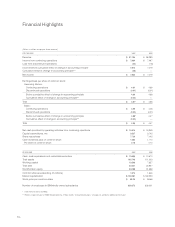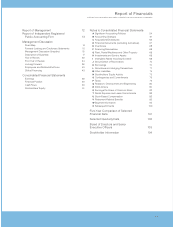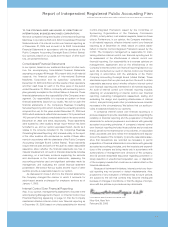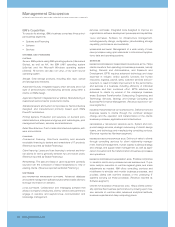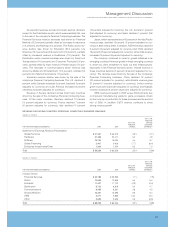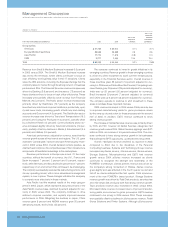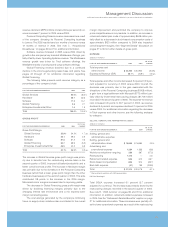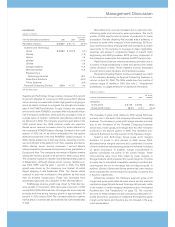IBM 2005 Annual Report Download - page 21
Download and view the complete annual report
Please find page 21 of the 2005 IBM annual report below. You can navigate through the pages in the report by either clicking on the pages listed below, or by using the keyword search tool below to find specific information within the annual report.
ManagementDiscussion
INTERNATIONALBUSINESSMACHINESCORPORATION ANDSUBSIDIARYCOMPANIES
20_ ManagementDiscussion
• Distribution:ConsumerProducts,Retail,Travel,Transportation
• Communications:Telecommunications,MediaandEntertain-
ment, EnergyandUtilities
• Small and Medium Business: Mainly companies with less
than1,000employees
INTERNALROUTES-TO-MARKET
Services consultantsfocusedonsellingend-to-endsolutionsfor
large,complexbusinesschallenges.
Hardwareandsoftwarebrandspecialists SellingIBMproductsas
parts of discrete technology decisions, and focusing on mid-
sizedclientsinterestedinpurchasing“turnkey”solutions,such
asthoseintheIBMExpressPortfolio.
ibm.com providesfast,easyaccesstoIBM’sproductandbusi-
nessexpertiseviatheWebandtelephone.Identifiesbusiness
opportunities for all of IBM’s routes to market and provides
online and telephone sales of standard hardware, software,
servicesandfinancingforallsizecompanies.
BUSINESSPARTNERSROUTES-TO-MARKET
Global/majorindependentsoftwarevendors. ISVsdeliverbusiness
processorindustry-specificapplicationsand,indoingso,often
influencethesaleofIBMhardware,middleware andservices.
Global/major systems integrators (SIS). SIS identify business
problemsanddesignsolutionswhenIBM Global servicesisnot
thepreferredsystemsintegrator;theyalsosellcomputinginfra-
structuresfromIBManditscompetitors.
RegionalISVsandSIS. SIS identifythebusinessproblems,and
ISVsdeliverbusinessprocessorindustry-specificapplications
tomedium-sizedandlargebusinessesrequiringIBMcomputing
infrastructureofferings.
Solutions providers, resellers and distributors. Resellers sell IBM
platformsandvalue-addedservicesaspartofadiscretetechnol-
ogyplatformdecisiontoclientswantingthird-partyassistance.
RESEARCH,DEVELOPMENT AND INTELLECTUAL PROPERTY
IBM’s research and development (R&D) operations differentiate
IBM from its competitors. IBM annually spends approximately
$5–$6billionforR&D,includingcapitalizedsoftwarecosts,focus-
ing its investments in high-growth opportunities. As a result
of innovations in these and other areas, IBM was once again
awardedmoreU.S.patentsin2005thananyothercompany.This
marksthe13thyearinarowthatIBMachievedthisdistinction.
Inadditiontoproducingworld-classhardwareandsoftware
products,IBMinnovationsareamajordifferentiatorinproviding
solutionsforthecompany’sclientsthroughitsgrowingservices
activities.Thecompany’sinvestmentsinR&Dalsoresultinintel-
lectualproperty(IP)income.SomeofIBM’stechnologicalbreak-
throughsareusedexclusivelyinIBMproducts,whileothersare
usedby the company’s licenseesfor their productswhen that
newtechnologyisnotstrategictoIBM’sbusinessgoals.Athird
groupisbothusedinternallyandlicensedexternally.
InadditiontotheseIPincomesources,the companyalso
generatesvaluefromitspatentportfoliothroughcross-licensing
arrangements and IP licensed in divestiture transactions. The
valueoftheseother two sourcesis not readilyapparentin the
financial results and Consolidated Statement of Earnings,
becauseincome on cross-licensing arrangements isrecorded
onlytotheextentthatcashisreceived.Thevaluereceivedby
IBMforIPinvolvingthesaleofabusinessisincludedintheover-
all gain or loss from the divestiture, not in the separately dis-
playedIPincomeamountsinfinancialresultsandConsolidated
StatementofEarnings.
INTEGRATED SUPPLY CHAIN
Just as IBM works to transform its clients’ supply chains for
greaterefficiencyandresponsivenesstomarketconditions,the
company continues to seebusiness value as itestablishesits
globally integrated supply chain as an on demand business,
transforming this function into a strategic advantage for the
company and, ultimately, improved delivery and outcomes for
its clients. Leveraging this experience, in June 2005, IBM
launched its supply-chainbusinesstransformationoutsourcing
service to optimize and help run clients’ end-to-end supply
chainprocesses,fromprocurementto logistics.
IBMspends approximately$38billionannuallythroughits
supply chain, procuring materials and services around the
world.Thecompany’ssupply,manufacturingand logisticsand
customerfulfillment operationsareintegratedinone operating
unitthathasreducedinventories,improvedresponsetomarket-
place opportunities and external risks and converted fixed to
variablecosts.Simplifyingandstreamlininginternal processes
has improved operations and sales force productivity and
processes and thereby the experiences of the company’s
clientswhenworkingwithIBM.Becausesomeofthecostsav-
ingsthisunitgeneratesarepassedalongtoclients,theywillnot
alwaysresultinavisiblegrossmarginimprovementinthecom-
pany’sConsolidatedStatementofEarnings.Whiletheseefforts
arelargelyconcernedwithproductmanufacturinganddelivery,
IBMisalsoapplyingsupply-chainprinciplestoservicedelivery
acrossitssolutionsandserviceslinesofbusiness.
In addition to its own manufacturing operations, the com-
panyusesanumberofcontractmanufacturing(CM)companies
aroundtheworld to manufactureIBM-designedproducts.The
useofCMcompaniesisintendedtogeneratecostefficiencies
and reduce time-to-market for certain IBM products. Some of
thecompany’srelationshipswithCMcompaniesareexclusive.
The company has key relationships with Sanmina-SCI for the
manufacture of some Intel-based products and with Solectron
for a significant portion of the manufacturing operations of


